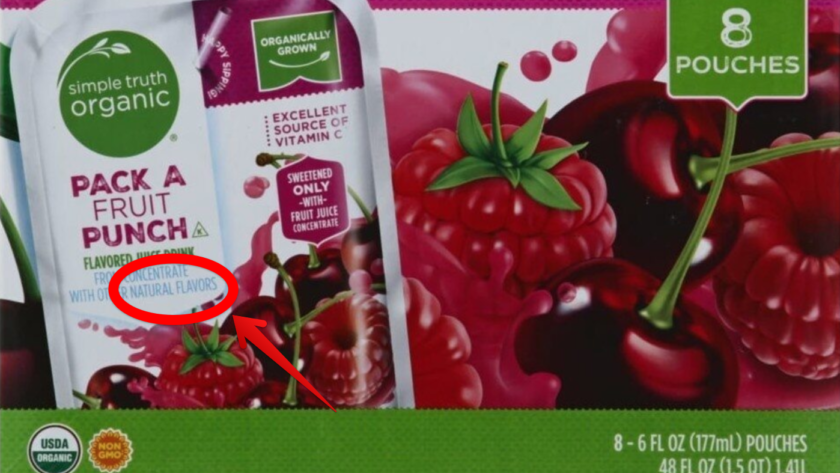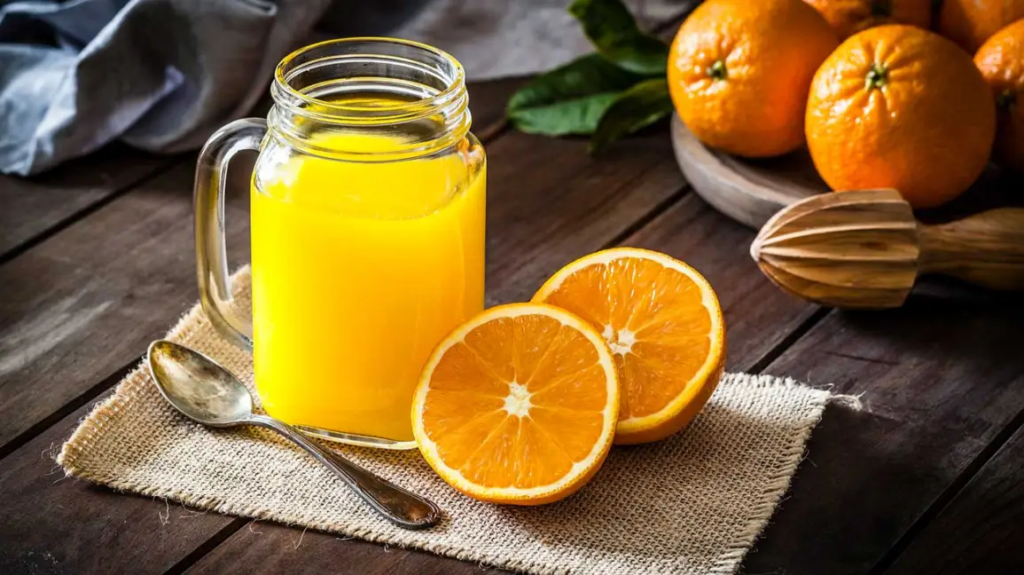
Image courtesy of kiliweb per Open Food Facts
If you’ve ever peered closely at a juice box or bottle, you’ve probably noticed a tiny label that says something along the lines of “from concentrate with other natural flavors.”
If that makes you think your latest pouch of delicious fruit perfection is cleaner and healthier, you’re not alone. A recent survey found that 89% of consumers believe that “natural flavors” qualifies as a clean label.
But is this really the case? The answer might surprise you.
What Natural Flavor Really Means For Your Juice
The FSA doesn’t seem to offer much in the way of a proper definition, but the US government goes further in-depth over what constitutes a “natural flavor” exactly.
The United States Food and Drug Administration defines “Natural Flavors” as such:
The essential oil, oleoresin, essence or extractive, protein hydrolysate, distillate, or any product of roasting, heating, or enzymolysis, which contains the flavoring constituents derived from a spice, fruit or fruit juice, vegetable or vegetable juice, edible yeast, herb, bark, bud, root, leaf or similar plant material, meat, seafood, poultry, eggs, dairy products, or fermentation products.
That’s quite a mouthful, so let’s unpack that definition.
Basically, natural flavors are defined as those which get their flavor from natural products like fruits, vegetables, spices, etc.
So that’s a good sign, right? If it’s just the extracts of natural products, then it surely offers at least some nutritional benefits, right?
Not exactly. The FDA elaborates that natural flavors’ “significant function in food is flavoring rather than nutritional.” That’s mainly because, to the government, natural is just anything that’s not man-made.
Normally, we associate nature with an inherent level of health, but that’s not always the case…
What the “Natural Flavors” Label Doesn’t Tell You
The “Natural Flavors” label is vague for a reason. It allows flavor manufacturers to hide a lot of non-natural preservatives and solvents that allow them to keep their delicious flavor.
According to David Andrews, a scientist with the research and advocacy group EWG, “there doesn’t seem to be much of a difference between natural and artificial flavors,” which is a big no-no for anyone looking to natural flavors for a nutritional source.
The government further places no restrictions on manufacturers to disclose what kind of ingredients they’re putting into these flavors, so a lot of times that refreshing juice might be filled with some not-so-natural ingredients.
People with food allergies should be particularly cautious of the “natural flavors” as these flavors are often derived from major allergens.
Luckily, the Big 8 allergens (tree nuts, wheat, eggs, dairy, wheat, soy, fish, and shellfish) are all required to be listed on the package if the food contains them.
That doesn’t do much good for people who have allergies to other foods, such as sesame, however, as these foods can still be covered up by the natural flavors labeling.
What About Artificial Flavors?
Artificial flavors are, pretty much, just any flavor derived from man-made sources.
They’re oftentimes made to mimic the taste of natural products at a lower price.
A perfect example of this is when flavor chemists (the people who compose artificial and natural flavors) mimic the taste of strawberries or cherries in your favorite candy.
You probably already expected these to be bad for you, and they are. Artificial flavors are known to cause a whole host of adverse reactions, including:
- Allergic reactions
- Chest pain
- DNA damage
- Fatigue
- Headaches
- Depression of the nervous system
- Brain damage
But again, when it comes to flavoring, there’s not much difference, nutritionally wise, between what’s considered “natural” and what’s considered “artificial.”
Why Distinguish “Natural” and “Artificial”?
It seems to be the case that “natural” and “artificial” labeling is mainly for flavor manufacturers to give the impression that their food is healthier or they’re not taking shortcuts in the lab.
That’s pretty much the case, as Dr. Pia Sorensen notes that “natural and artificial flavors are the exact same molecules.”
From a molecular point of view, there’s no difference between the two, so it’s difficult to justify putting “natural” in front of one flavor and “artificial” in front of another.
However, some might argue that natural flavors have higher quality as they’re more expensive for companies to produce, so the labeling of a “natural flavor” can help justify that higher price tag to consumers.
Conclusion
So, in reality, the differentiating between “natural” and “artificial” flavors is largely misleading, as both products have the same molecular structure and one doesn’t offer more health benefits than the other.
;
That’s why it’s so important to look at the labeling of your foods. Be on the lookout for foods labeled organic as these foods are not only required to severely minimize the use of synthetic chemicals, but they also are healthier for the environment.
It seems like food can absolutely get a lot more natural than “natural flavors.”
FAQs
What regulations, if any, are flavor manufacturers subject to?
In the UK, a rigorous regulation process is put in place for risk management and assessment of all flavors.
This seems to follow a more general format for food safety rather than flavoring specifically, but it’s still comforting to know that flavoring gets the same treatment as other foods in the eyes of the law.
Does this mean I can’t eat natural flavors?
That’s up to you.
If you do want to avoid natural flavors, some great nutritional routes to go down are eating organic foods or foods that may not necessarily be fully organic but aren’t heavily processed.
It’s always a good idea to read the packaging so you know exactly what’s going on in your food or call the food company if you’re still unsure.
What are some examples of natural flavors?
Some popular natural flavors are:
- Amyl Acetate – derived from bananas
- Citral – derived from lemon, lemongrass, oranges, and pimento
- Benzaldehyde – commonly derived from almonds or cinnamon oil
- Linden ether – derived from honey
- Massoia lactone – derived from coconut
- Acetoin – derived from butter





